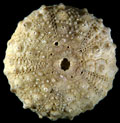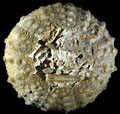The Echinoid Directory
Hessotiara Pomel, 1883, p. 97
[= Parastomechinus Philip, 1963, p. 1111, type species Parastomechinus brightoni Philip, 1963]
| Diagnostic Features |
|
|---|---|
| Distribution | Jurassic (Bathonian-Oxfordian), Europe, North America, Arabian Peninsula. |
| Name gender | feminine |
| Type | Diadema florescens Agassiz, 1840, p. 17 by monotypy. |
| Species Included |
|
| Classification and/or Status | Acroechinoidea, Carinacea, Pseudodiadematidae. |
| Remarks | Most specimens labeled as Hessotiara in museum collections are simply the juvenile of a Gymnocidaris. Hessotiara differs from Pseudodiadema principally by having a rather sharp decline in the size of primary ambulacral tubercles a little above the ambitus. In Pseudodiadema, the tubercles decrease in size gradually towards the apex. The difference is slight and there may be no clear distinction possible between these two genera. Hypodiadema is also very similar but has smaller, less well developed ambulacral tubercles above the ambitus. |




